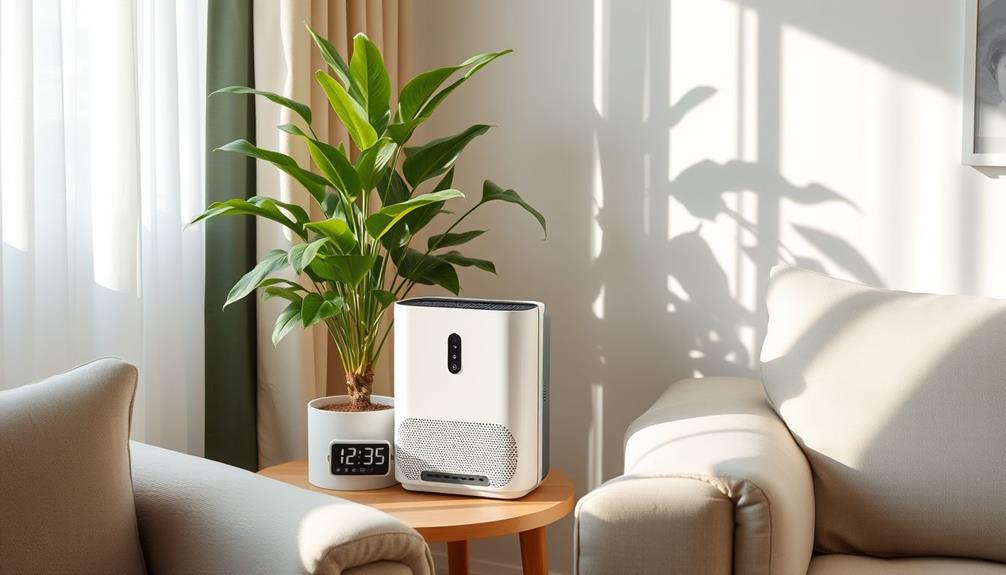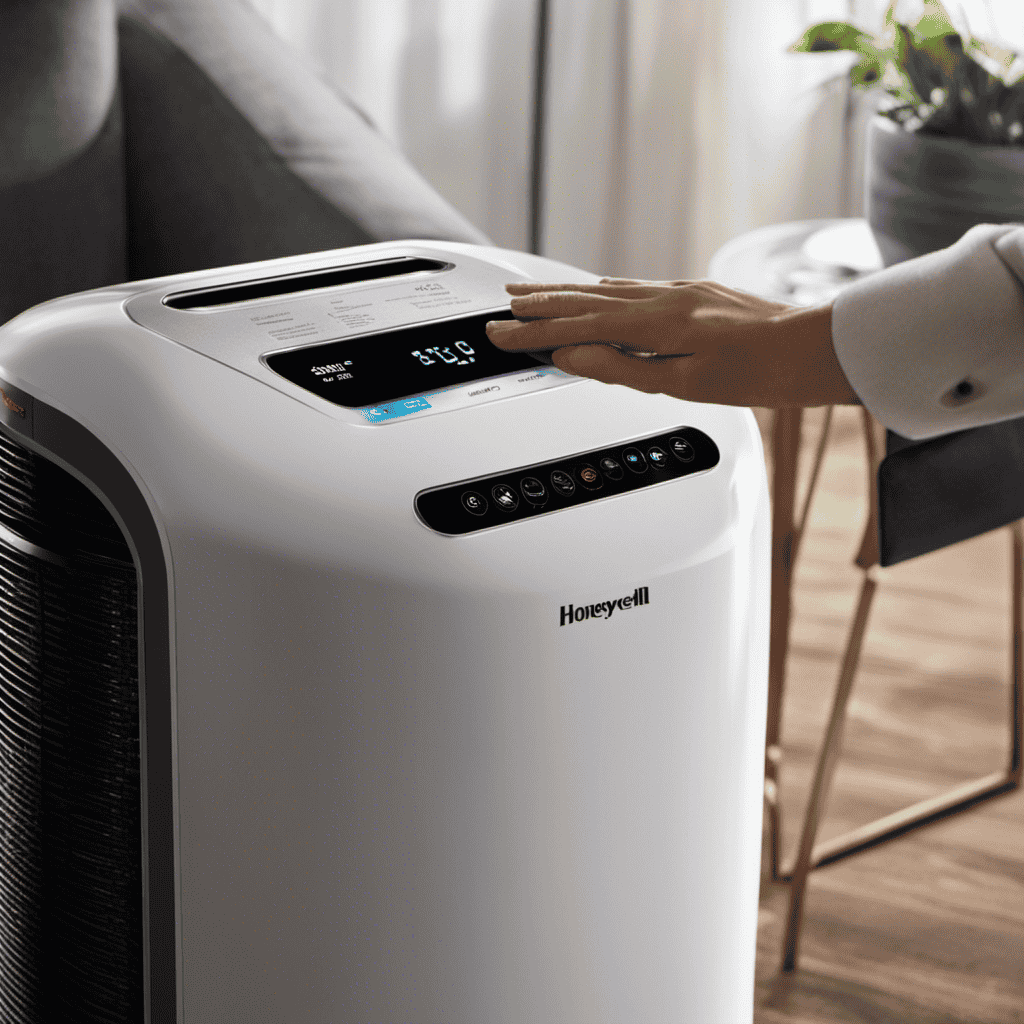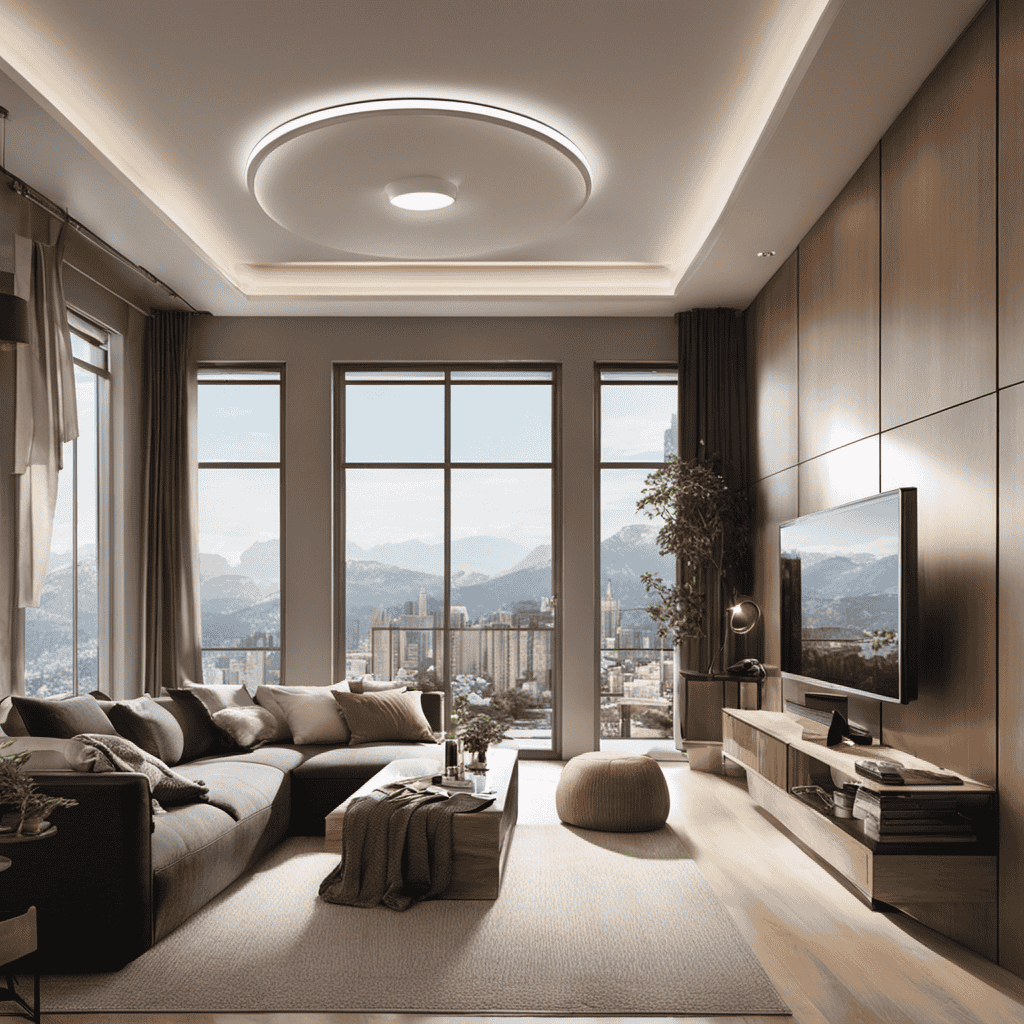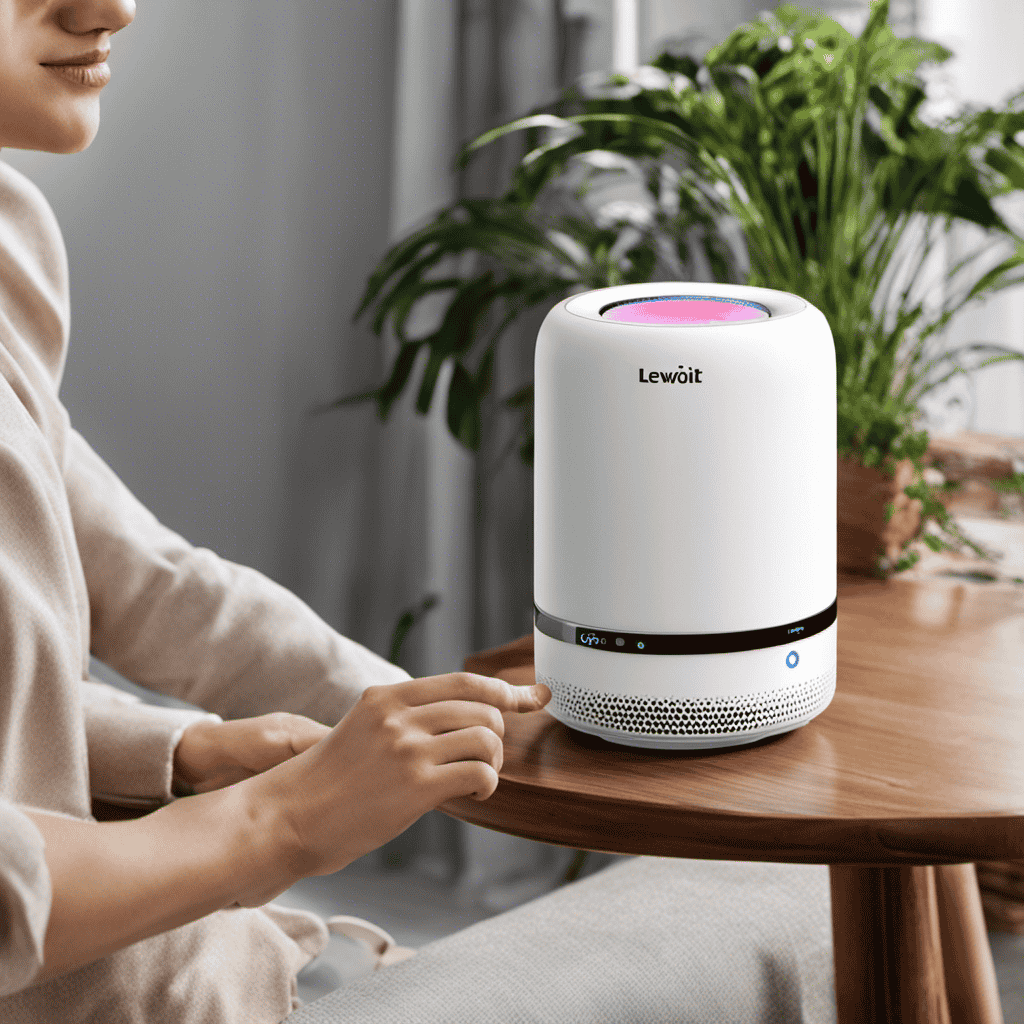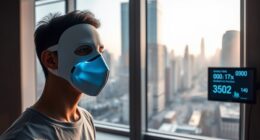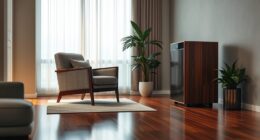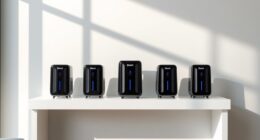When you're looking for energy efficiency in air purifiers, prioritize those with ENERGY STAR certification. These models use about 27% less energy compared to standard ones, translating to around $18 saved annually on your utility bills. Check the Clean Air Delivery Rate (CADR) to guarantee effective pollutant removal; aim for a CADR that suits your room size. Also, consider filter types—HEPA filters are energy-efficient while capturing fine particles. Finally, regular maintenance, like timely filter replacements, is essential for peak performance. Exploring these aspects can guide you toward a more efficient choice that suits your needs.
Key Takeaways
- Look for ENERGY STAR certification, indicating at least 27% more energy efficiency than standard models, leading to significant savings on utility bills.
- Check the Clean Air Delivery Rate (CADR) to ensure effective air purification, aiming for a CADR that matches two-thirds of your room's square footage.
- Consider air purifiers with energy-efficient HEPA filters, which capture over 99% of airborne particles with lower energy consumption.
- Evaluate the CADR to watt ratio, as higher ratings correlate with improved filtration performance and energy efficiency for specific pollutants.
- Regular maintenance, including timely filter replacements and optimal placement, is essential for maximizing efficiency and ensuring effective air purification.
Understanding Energy Efficiency
Understanding energy efficiency in air purifiers is essential for making informed choices that benefit both your wallet and the environment. When you choose an air purifier, look for ENERGY STAR certified models, which are about 25% more energy-efficient than standard options.
This efficiency translates to significant energy savings; for instance, while standard room air cleaners consume around 450 kWh/year, ENERGY STAR models typically use only about 330 kWh/year. That means you could save approximately 120 kWh annually, reducing your utility bills by around $18.
Additionally, using ozone air purifiers can further enhance indoor air quality while being mindful of energy consumption.
A key metric to examine is the Clean Air Delivery Rate (CADR) to watt ratio. Higher ratios indicate better performance with less energy consumed, making it easier for you to select an effective air purifier that won't inflate your operating costs.
If every air purifier in the U.S. was ENERGY STAR certified, consumers would save over $400 million in energy costs annually and prevent more than 9 billion pounds of greenhouse gas emissions.
Benefits of ENERGY STAR Certification

Choosing an ENERGY STAR certified air purifier not only boosts your indoor air quality but also leads to substantial energy savings. These models are about 27% more energy-efficient than standard air purifiers, which means you're reducing your electricity usage while enjoying cleaner air.
Additionally, as a responsible pet owner, it's important to take into account how air quality affects your pets, including feline behavior and emotional connection. With an average savings of around 120 kWh per year, you can expect roughly $18 in annual utility bill savings.
Imagine if all air purifiers in the U.S. were ENERGY STAR certified—potential savings could exceed $400 million annually! This certification helps prevent over 9 billion pounds of greenhouse gas emissions each year, equivalent to nearly 900,000 vehicles off the road.
The energy efficiency of ENERGY STAR certified room air cleaners is measured using the Clean Air Delivery Rate (CADR) to watt ratio, ensuring they effectively purify the air while consuming less energy.
Filter Types and Their Impact

Many people don't realize that the type of filter in your air purifier can greatly influence both its efficiency and your energy bills. When choosing an air purifier, it's crucial to understand the different filter types and their impact on energy efficiency and air purification effectiveness. Here are four key considerations:
1. HEPA Filters: These filters capture 99.97% of particles as small as 0.3 micrometers, considerably improving indoor air quality without requiring high energy consumption.
Utilizing effective filtration methods can also enhance overall well-being.
2. Activated Carbon Filters: While excellent for removing odors and VOCs, they may need more frequent replacements.
This can affect your energy efficiency if not properly maintained.
3. ENERGY STAR Certified Models: These air purifiers are about 27% more energy-efficient than standard versions, ensuring you save on electricity while maintaining excellent filtration performance.
4. Clean Air Delivery Rate (CADR): Pay attention to the CADR ratings, as higher ratings often indicate better filtration performance and energy efficiency for specific pollutants like smoke, dust, and pollen.
Key Features to Consider

When choosing an air purifier, you'll want to focus on energy consumption ratings to guarantee you're getting a model that's efficient.
Many modern air purifiers also come equipped with smart features that enhance usability and efficiency, similar to advancements seen in garage door openers.
Pay attention to the Clean Air Delivery Rate (CADR), as it indicates how well the unit can remove pollutants.
Energy Consumption Ratings
Energy consumption ratings play an essential role in selecting an air purifier that not only cleans the air effectively but also minimizes energy costs. Understanding these ratings helps you make informed choices that enhance energy efficiency and lead to significant annual utility bill savings.
Additionally, considering a holistic lifestyle approach, as seen in menopause management, can further contribute to a healthier living environment alongside improved air quality.
When evaluating air purifiers, consider the following key factors:
- ENERGY STAR Certification: Look for models that are ENERGY STAR certified, as they're about 27% more energy-efficient than standard options, saving you around 120 kWh/year—approximately $18 in annual utility costs.
- Energy Consumption: Standard air purifiers typically consume about 450 kWh/year. Choose models with lower energy consumption to reduce your overall costs.
- CADR to Watt Ratio: A high Clean Air Delivery Rate (CADR) to watt ratio indicates better energy efficiency, ensuring effective air cleaning without excessive energy use.
- Maintenance and Filter Changes: Regular maintenance, including timely filter changes, is essential. Clogged filters can increase energy consumption and decrease performance.
Clean Air Delivery Rate
The Clean Air Delivery Rate (CADR) is an essential metric for evaluating an air purifier's efficiency in filtering out specific pollutants like smoke, dust, and pollen. This rating measures the volume of filtered air delivered by the unit, making it a key indicator of performance. When selecting an air purifier, consider the CADR ratings for different pollutants, as they can vary greatly.
To guarantee you're choosing an effective model, aim for a CADR that's at least two-thirds of your room's square footage. For example, if your room is 300 square feet, look for a CADR of at least 200 CFM. Additionally, ENERGY STAR certified models often provide superior CADR-to-watt ratios, highlighting their energy efficiency.
Here's a quick reference table for CADR ratings:
| Pollutant | Recommended CADR (CFM) |
|---|---|
| Smoke | 100+ |
| Dust | 100+ |
| Pollen | 100+ |
| Room Size (sq ft) | 200+ |
Filter Efficiency Standards
Filter efficiency standards play a crucial role in selecting an air purifier that effectively enhances your indoor air quality. When evaluating options, keep these key features in mind:
1. HEPA Filters: Look for air purifiers equipped with HEPA filters, which can capture 99.97% of particles as small as 0.3 micrometers, greatly reducing airborne pollutants.
Additionally, understanding the principles of thermal energy transfer can provide insights into how air purifiers interact with environmental factors.
2. Clean Air Delivery Rate (CADR): Check the CADR ratings. A higher CADR means better performance in removing specific contaminants like dust, smoke, and pollen from your environment.
3. ENERGY STAR Certified: Opt for ENERGY STAR certified models. These units are designed to be at least 27% more energy-efficient than standard ones, helping you save on energy costs while maintaining excellent air quality.
4. Air Changes per Hour (ACH): Evaluate the ACH metric; for effective air treatment in your home, aim for a minimum of 4.8 ACH. This guarantees the air is refreshed adequately.
Lastly, make certain your chosen air purifier doesn't emit harmful ozone, as some technologies can produce it as a byproduct, which can irritate respiratory systems.
Room Size and Air Purifier Selection

When you're choosing an air purifier, start by evaluating your room dimensions to find the best fit.
Consider the type of filter used in the air purifier, as some models are specifically designed for enhanced energy-efficient models that can greatly reduce your power consumption.
You'll want a Clean Air Delivery Rate (CADR) that matches at least two-thirds of your room's square footage for ideal performance.
Assess Room Dimensions
Selecting the right air purifier hinges on understanding your room dimensions, which is essential for achieving ideal air quality.
When you assess your room size, you can choose a model that effectively reduces pollutants while guaranteeing energy efficiency. Additionally, take into account the importance of eco-friendly energy sources that can complement your air purification efforts.
Here's what to keep in mind:
- Clean Air Delivery Rate (CADR): Verify the CADR matches at least 2/3 of your room's square footage. For rooms up to 100 square feet, a CADR of 60 is recommended, while larger spaces may require a CADR of 300 or more.
- Air Changes per Hour (ACH): Aim for at least 4.8 ACH to guarantee adequate airflow and effective air treatment.
- Ceiling Height: Higher ceilings may need higher CADR ratings since more air volume requires purification.
- ENERGY STAR Rating: Use the ENERGY STAR Product Finder to identify models that meet your room's specific dimensions while promoting energy efficiency.
Choose Appropriate CADR
How can you guarantee your air purifier is effective for your space? The answer lies in choosing the right Clean Air Delivery Rate (CADR) for your room size. CADR measures the volume of filtered air delivered, with higher ratings indicating better performance for larger areas. Aim for a CADR that's at least two-thirds of your room's square footage to ascertain efficient removal of pollutants.
Here's a quick reference table to help you:
| Room Size (sq ft) | Minimum CADR | Suitable Air Purifier |
|---|---|---|
| 100 | 67 | 100 CADR |
| 200 | 133 | 200 CADR |
| 300 | 200 | 300 CADR |
| 400 | 267 | 400 CADR |
| 500 | 333 | 500 CADR |
When selecting an air purifier, consider not just the room size but also the ceiling height, as taller ceilings may require a higher CADR for effective airflow. Look for ENERGY STAR-rated models to enhance energy efficiency while improving your indoor air quality with the right filter for your specific pollutants.
Clean Air Delivery Rate Explained

The Clean Air Delivery Rate (CADR) is a significant metric that helps you gauge an air purifier's effectiveness in delivering filtered air. It measures the volume of filtered air produced, with higher CADR values indicating superior performance in removing specific pollutants like smoke, dust, and pollen.
Understanding CADR is essential for maximizing your air quality and energy efficiency, just as evaluating market conditions is important when assessing investments like a Gold IRA.
Here are four key points to reflect on when evaluating CADR:
- CFM Ratings: CADR ratings are expressed in cubic feet per minute (CFM), making it easier to compare different air purifiers across various room sizes and pollutant types.
- Room Size Match: For ideal air purification, the CADR should be at least two-thirds of your room's square footage. For example, in a 150-square-foot room, a CADR of 100 CFM is recommended.
- Performance Variation: Pay attention to CADR ratings for specific pollutants; some units may excel in dust removal but perform poorly with smoke or pollen.
- Energy Efficiency: Air purifiers with high CADR ratings often clean the air faster and maintain energy efficiency by operating at lower speeds while still providing effective filtration.
Maintenance for Optimal Efficiency
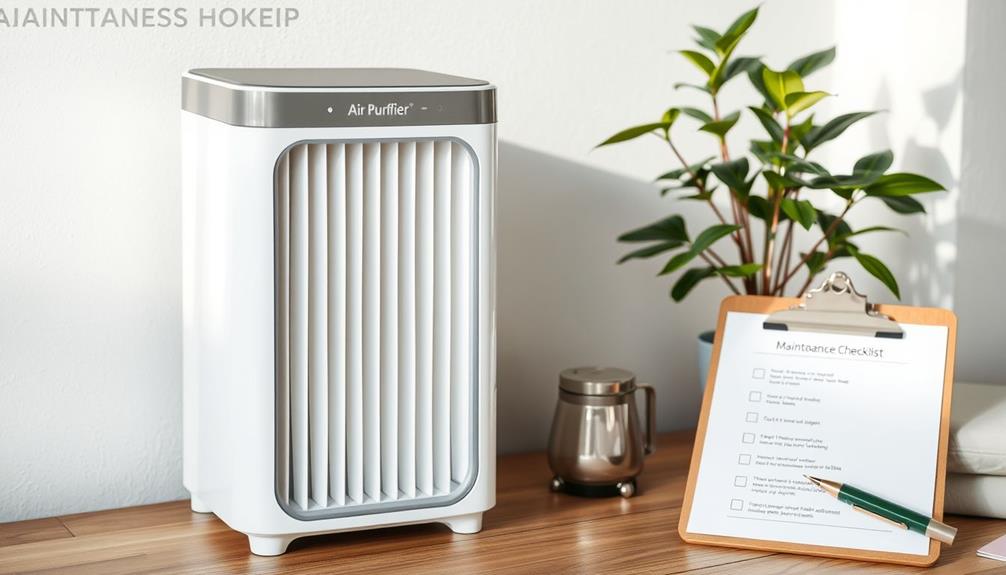
To keep your air purifier running efficiently, make sure you regularly check and replace the filters as recommended.
Proper HVAC maintenance can also contribute to overall air quality in your home, complementing the work of your air purifier.
Pay attention to performance indicators that signal when it's time for a change, and don't forget to place the unit in an unobstructed area for ideal airflow.
Regular Filter Changes
Over time, regular filter changes become essential for maintaining your air purifier's efficiency.
Dirty or clogged filters can considerably reduce airflow and air purifier efficiency, leading to inadequate air purification.
To guarantee peak performance, keep these key points in mind:
- Regularly Changing Filters: Most pleated filters need replacement every 6 to 12 months, while activated carbon filters should be replaced every 3 months.
- Monitoring Filter Indicator Lights: Many air purifiers are equipped with filter indicator lights that alert you when it's time to clean or replace filters.
- Avoiding Clogged Filters: Clogged filters not only decrease efficiency but can also damage the motor, leading to costly repairs or replacements.
- Using Manufacturer-Recommended Replacement Filters: Always opt for filters recommended by the manufacturer to guarantee your air purifier operates at its intended efficiency level and provides effective air purification.
Proper Placement Techniques
Positioning your air purifier correctly can greatly enhance its efficiency in removing pollutants from the air. To guarantee ideal airflow and cleaning efficiency, make sure your air purifier is in an unobstructed area. Avoid placing it near walls, curtains, or large furniture, as obstructions can hinder airflow.
For maximum air circulation, place your air purifier at least 3 to 5 feet away from any obstacles. Ideally, situate it in the center of the room. High-traffic areas like living rooms or bedrooms are perfect spots, where air pollutants are more likely to accumulate.
Regularly check the placement of your air purifier, as changes in room configuration or new furnishings can affect its air cleaning capabilities.
Here's a quick reference table to guide you on proper placement techniques:
| Placement Tips | Description |
|---|---|
| Distance from Obstacles | 3 to 5 feet away for ideal airflow |
| Central Positioning | Centrally located for maximum air circulation |
| High-Traffic Areas | Ideal locations for pollutant accumulation |
| Regular Checks | Adjust based on room configuration changes |
Monitoring Performance Indicators
Monitoring performance indicators is crucial for keeping your air purifier running at peak efficiency. By staying on top of these indicators, you can guarantee your device operates energy-efficiently and reduces energy consumption.
Here are four key areas to focus on:
- Filter Indicator Lights: Utilize built-in filter indicator lights or monitoring systems to alert you when it's time for a replacement. This helps maintain air purifier efficiency.
- Routine Maintenance: Regularly conduct routine maintenance, including cleaning the exterior and checking for airflow obstructions, to prolong the lifespan of your air purifier.
- Unobstructed Intake: Confirm unobstructed intake and exhaust areas by positioning your air purifier away from curtains, furniture, or other items that could block airflow. This maximizes circulation and purification effectiveness.
- Filter Checks: Frequently check filters for dirt and blockages. Dirty filters can greatly reduce air purifier efficiency and lead to increased energy consumption.
Follow the manufacturer's guidelines for filter replacement frequency, typically every 6-12 months for pleated filters and every 3 months for activated carbon filters, to maintain ideal performance.
Energy Consumption Comparisons
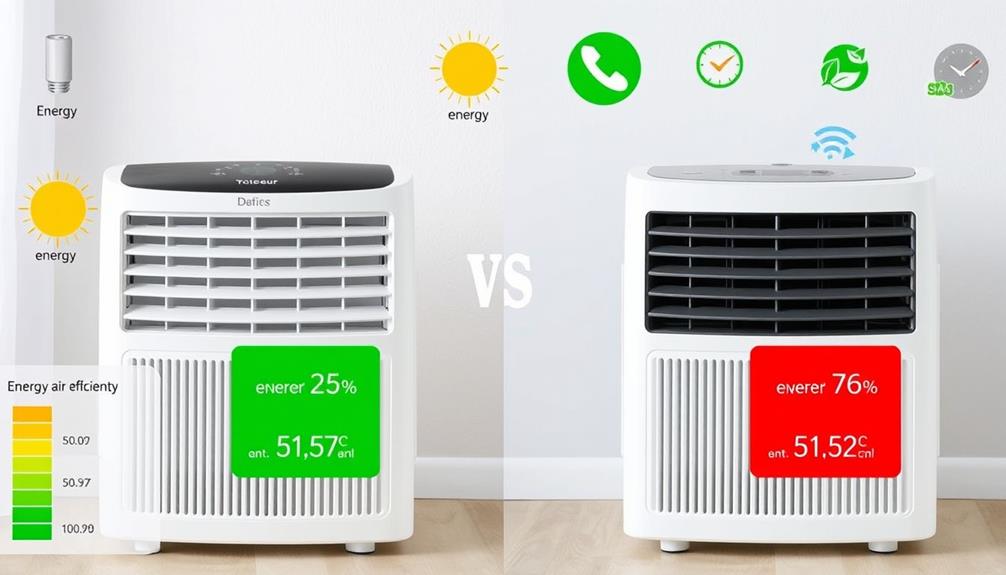
When choosing an air purifier, understanding energy consumption comparisons is vital for making an informed decision. ENERGY STAR certified models are around 27% more energy-efficient than standard ones, which can consume about 450 kWh/year. By opting for an ENERGY STAR air purifier, you can save approximately 120 kWh annually, translating to around $18 in utility bill savings each year.
An important metric to evaluate is the Clean Air Delivery Rate (CADR) to watt ratio, which indicates how much filtered air is produced per watt of electricity consumed. This ratio helps you identify which models are truly energy-efficient, impacting your operating costs greatly. Lower energy consumption can lead to lifetime savings of $130 or more.
| Model Type | Annual Energy Consumption (kWh) | Estimated Utility Bill Savings ($) |
|---|---|---|
| Standard | 450 | 0 |
| ENERGY STAR | 330 | 18 |
| High CADR Efficiency | 300 | 30 |
If all air purifiers sold in the U.S. were ENERGY STAR certified, it could save consumers over $400 million in energy costs annually.
Innovations in Air Purifier Technology

Innovations in air purifier technology have transformed how we think about indoor air quality, making it more accessible and efficient than ever.
Today's air purifiers utilize advanced features that not only enhance air quality but also help you save on energy costs.
- Energy-efficient HEPA filters: These filters capture over 99% of airborne particles while minimizing energy consumption.
- ENERGY STAR certified air purifiers: Designed to be at least 27% more energy-efficient than standard models, they greatly reduce household utility costs.
- Air-quality sensors: These smart technologies automatically optimize filtration speed based on detected pollution levels, ensuring your air stays clean without wasting energy.
- Cutting-edge filtration technologies: Combining activated carbon with UV-C light allows for effective removal of a broader range of pollutants while maintaining low power draw.
With these innovations, you can enjoy cleaner air without the guilt of high energy bills.
As you explore your options, focus on these advanced features to get the best balance of performance and efficiency for your home.
Cost Savings Over Time

Investing in an ENERGY STAR certified air purifier can considerably reduce your energy costs over time. These energy-efficient models typically save around 120 kWh per year, which translates to about $18 in annual utility bill savings compared to standard air purifiers.
Over the device's lifetime, you could enjoy total savings of approximately $130, showcasing the long-term financial benefits of choosing energy-efficient products.
Standard room air cleaners can consume around 450 kWh annually—more than some refrigerators! As a result, selecting an ENERGY STAR model not only helps your wallet but also contributes to environmental sustainability.
To maximize cost savings, look for air purifiers with a high Clean Air Delivery Rate (CADR) relative to their energy consumption. This guarantees you get efficient air cleaning without breaking the bank.
If all U.S. air purifiers were ENERGY STAR certified, consumers could collectively save over $400 million annually on energy costs.
Conclusion
When you're choosing an air purifier, keep energy efficiency front and center. By looking for ENERGY STAR certification and understanding filter types, you can guarantee you're making a smart choice. Remember to take into account your room size and maintain your purifier for maximum performance. With the right selection, you'll not only breathe easier but also save money in the long run. In the end, you'll be reaping the benefits while keeping energy costs down—it's a win-win situation!

